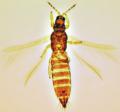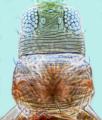Thrips konoi
Recognition data
Distinguishing features
Both sexes fully winged. Abdomen varying from light yellowish brown to uniformly brown; head and thorax brown, legs brownish yellow; antennal segment III yellow in basal third; fore wing pale to weakly shaded. Head wider than long; two pairs of ocellar setae, pair III arising just outside anterior margins of ocellar triangle; postocular setae pair I about as long as ocellar setae pair III, but pair II smaller than pair III. Antennae 7-segmented; III–IV with short forked sensorium; segment VII short. Pronotum with 2 pairs of long posteroangular setae; 3 pairs of posteromarginal setae. Metanotum with closely spaced longitudinal lines medially; median setae arising behind anterior margin; campaniform sensilla present. Fore wing first vein with 3 setae on distal half; second vein with about 12 setae; clavus with 5 marginal setae. Abdominal tergite II with 3 lateral marginal setae; tergites V–VIII with ctenidia present laterally, on VIII posteromesad to spiracles; tergite VIII posteromarginal comb with long slender microtrichia; pleurotergites with no discal setae, lines of sculpture bearing broadly based teeth. Sternite II with 2 pairs of marginal setae, III – VII with 3 pairs, no sternal discal setae.
Male smaller than female; sternites III–VII with transverse or oval pore plate.
Related and similar species
In contrast to T. nigropilosus, tergite IX of T. konoi has two pairs of campaniform sensilla instead of one, and the metanotum is more closely striate. The genus Thrips is the second largest genus in the Thysanoptera, and currently includes, worldwide, about 285 species. All members of the genus lack ocellar setae I on the head, and they all have ctenidia on tergite VIII posteromesad to the spiracles. Other characters, such as number of antennal segments, number of setae on the fore wing veins, and number of discal setae on the sternites are variable between species (Palmer, 1992; Nakahara, 1994; Mound & Masumoto, 2005).
Taxonomic data
Current valid name
Thrips konoi Nakahara
Original name and synonyms
- Thrips konoi Nakahara, 1994: 77
Family placement
Thripidae, Thripinae
Biological data
Life history
Probably flower-living
Host plants
Adults collected in considerable numbers from Carex (Cyperaceae).
Tospoviruses vectored
None
Crop damage
None
Distribution data
Area of origin
Western USA
Distribution
California, Colorado.







